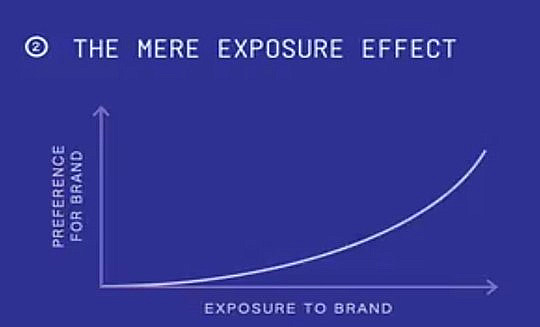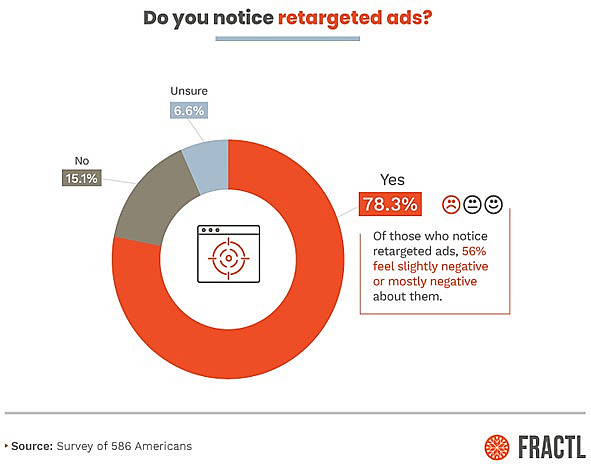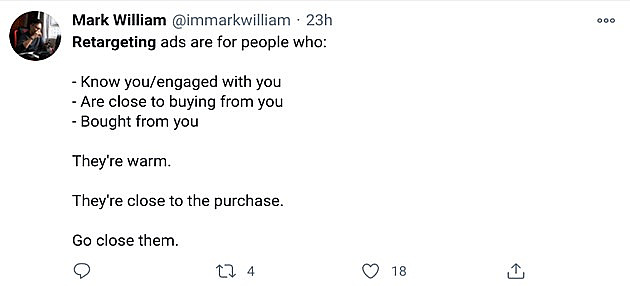How many times have you added a consumer product to your virtual cart only to get distracted, hesitate, or simply exit out of the window? And how many times have you seen an ad for the very same product on your Instagram or Facebook feed less than three hours later?
That is social retargeting, and it is one of the most powerful tools in marketers' arsenals today— and, no, not only for e-commerce marketers.
One challenge facing businesses comes from consumers who quit the race 10 feet from the finish line: They click on an engaging post on social media or a call to action in your email newsletter, add items to their cart, and fill out some of the shipping and billing information, but they do not make the purchase. The same thing can happen with potential clients about to fill out your contact form.
Distraction, indecision, or a change of heart are all reasons someone might abandon a considered purchase or not send a contact form, and it's a marketer's job to use incentives to create a paying customer.
Social Media Retargeting for Selling Services
Retargeting is especially efficient at improving brand awareness and recognition during the buying process—and not just for buying products.
If a CMO at a company wants a new website, plans to hire an agency to do an SEO audit, or needs to outsource content for the company site, the CMO is going to do a lot of research to make sure the selected vendor will return the most impact on the company's investment. And 99% of that research will be conducted online.
If CMOs come across your services and begin to weigh you against your competitors, you can use social retargeting to remind those potential clients about your brand as they go about their daily lives. You might have had an introductory call during the workday, but retargeting will nudge them in your direction when they're on their off time, at home, scrolling social media.
Retargeting and the Mere-Exposure Effect
Retargeting ads will improve conversions, no doubt about it. But, why do retargeting ads work?
The mere-exposure effect is one of the more persuasive psychological phenomena used in marketing. The mere-exposure effect states that the more you see something, the more likely you are to trust or prefer it.
It even works with interpersonal relationships. Imagine walking to work every day and seeing the same person cross your path for months. One day you're running late and decide to take a different route. You will subconsciously assign more trust to the person you're familiar with than the people you meet on the new route.
Retargeting ads work on this premise: The more you see a brand or business, the more likely you are to trust it, especially if its message is positive.
Embracing the Mere-Exposure Effect for Agencies
When you continue to show potential clients case study ads on various social platforms, the case study success story will appear as an image or video on the page as they browse their social media feed. They will begin to associate your brand with impressive results. Less-savvy users might even confuse it for endorsement.

One last, unobvious benefit of using social retargeting to generate leads for your agency is that it builds thought leadership with future customers. As buyers do research on "content marketing," for example, retargeting them with your expertly written guides and industry research will build trust in a new way. They will come to associate your brand not only with your service offerings but also with your industry leadership.
The Monetary Benefits of Retargeting for Agencies
Retargeting provides monetary benefits that will reduce the costs of digital ads while raising their effectiveness.
Improve clickthrough rates
Using retargeting, you can target a user who has already shown interest in your product or service instead of targeting a mass audience. Those interested users will reduce your ad costs, improve clickthrough rates (CTR), and raise your overall conversion rates.
Reclaim leads
Retargeting also gives you the ability to reclaim users who may have abandoned their purchase or left during the conversion process. You can target that user with the specific items they are interested in, instead of random products.
How to Optimize Landing Pages for Social Media Retargeting
Collect contact information
If you're an agency, you're likely offering services rather than products. Landing pages for you might be client case studies, exclusive research related to your industry, or expert thought leadership blog posts.
The main thing you need to track for initial visits are pixels or email addresses. Both are valuable, although pixels are automatic. Make sure you drop a retargeting pixel, and that it's segmented.
For example, at Fractl we have a case study specific to a financial services client. From that, we could assume traffic to that page includes people interested in content marketing success for finance-related topics. We could track their pixels and then segment them into finance-based campaigns that showcase our experience in the financial vertical, whether that's through blog posts, research we've done, or further case studies.
Optimize the post-click landing page
You can have massive contact lists, fine-tuned segmentation, and creative content, but if you don't have a landing page that's optimized to drive leads through the sales funnel... then all of that is for naught.
Such pages shouldn't just be other blog post pages on your site; they should each be optimized for the intent of your audience. They should be as sticky as possible and they should include a compelling call to action (CTA) that aligns with your agency's goals.
That's all because social traffic normally has high bounce rates, so you need to do your best to keep the traffic on the page and drive visitors through the funnel. One way to do so would be to end with related content that's more bottom-of-the-funnel, or invite the lead to fill out a form for a free 30-minute consultation on your service offerings.
Is retargeting intrusive?

In a 2019 inbound marketing survey of respondents noticing retargeted ads, just over half said they feel slightly negative or mostly negative about them.
I get it. The ad for headphones that I almost bought bombarded me for months. I was annoyed. I was paranoid. But I did end up making a purchase in the end.
My guess is that retargeting feels more intrusive than other ad types because a consumer could feel bombarded with all of the personalized ads, as if they're being stalked wherever they go on the Internet.
To avoid frustration among your potential clients, try to switch it up in your ads. Continue to hyper-focus on your segment, but use off-brand colors or remove your logo from the ad. Focus less on your branding and more on the service you are trying to sell.
Common Retargeting Mistakes to Avoid
Some of the most significant issues tend to occur after the user has been tracked and lists have been built:
- Failing to segment your list. If a user is visiting your site looking for a push lawn mower and you're showing them ads for an industrial tractor mower, they will most likely not click.
- Using generic ads that all look the same. Make unique ads for your segmentation, and make them stand out so users don't get tired of the same branding from your website.
- Setting the same tracking cookie time limit for everyone. The tracking limit should depend on your niche's buying time process. Larger ticket items (six-month contracts, for example) usually mean a longer buying process, so you may need 120 days of tracking, whereas smaller items may only need 30 days of tracking.
- Failing to update your list. Retargeting users who have already converted can happen, especially with pixel-based tracking, so make sure the lists are kept up to date.
- Showing your ads too many times to the same person can make that person not want to visit your site or engage with your content again. Limit the ad frequency in your campaigns so potential clients aren't saturated with your content.
The most common mistake made by marketers is to not focus enough on segmentation. If you segment inaccurately, you can kiss your money goodbye.
Customizing the ad experience to be timely and highly relevant to each person is what makes retargeting an effective and inexpensive tactic. Your landing pages, ad copy, and content should be created with the consumer's intent in mind, every time.
Social Media Retargeting Implementation Examples for Agencies
If you want to begin using retargeting for your agency, here are a few questions to get you started.
Where are your potential clients spending their time?
Are they on Twitter, LinkedIn, or Instagram? Hit them with ads where they are.
What can you provide to your audience for free? What do they need help with?
Make buyers' lives simpler before you even sell them. Offer an "Ultimate Guide" or template that will make their jobs easier. Provide value first; then it will become easier to sell because they will remember your brand positively.
What are your competitors doing? Can you do it better?
If your competitors are already ahead of the game with retargeting, head over to their site and see what their on-site content looks like. Are they offering free resources or case studies? What are their CTAs?
Allow yourself to be tracked, and take a look at the ads that are retargeted to you. Analyze their efforts and optimize yours so your ads perform even better.
Do you have content for each stage of the buyer's journey?
The first page your customer visits is going to be different for each unique visitor. Some visitors might land on a blog post that is designed for the awareness stage. Another might land directly on a case study that is more middle of the funnel, or the consideration stage. Then another might land on your services page, which is at the bottom of the funnel: the decision stage.

In other words, people visit your website at various stages of the buyer cycle, so make sure you have enough content to segment according to their stage.
The first ad you show someone who's ready to make a purchase shouldn't be 10-year-old how-to content. Conversely, if someone recently browsed a tutorial on your site, you shouldn't be showing them ads for free consultations.
* * *
Social retargeting as a marketing tactic will return big on your investment if you strategize. Be deliberate and thorough with segmenting. Optimize your landing pages. Test new CTAs. Explore new content formats. Test out video ads. Pause your campaigns and reboot them later on. Change your ad copy. Always be tweaking your campaigns.
The goal is to keep tweaking until ROI is at its highest.
More Resources on Social Media Retargeting
Six Lead Generation Tactics to Use in Your Social Media Channels
B2B PPC Tactics: Six Ways to Bring in Higher-Quality Leads
Three Easy Ways to Use LinkedIn Sales Navigator for Marketing






